Planning & Assessing Inclusive Teaching to Meet Learner Needs
VerifiedAdded on 2023/06/15
|31
|7484
|125
Report
AI Summary
This report provides an analysis of key teaching practices, focusing on meeting the diverse needs of learners in education and training. It explores the roles and responsibilities of a teacher, emphasizing the importance of communication, assessment, and understanding individual learning capabilities. The report summarizes relevant legislation, regulatory requirements, and codes of practice, including the Equality Act 2010 and the Data Protection Act 1989, highlighting the need for equality, data security, and ethical conduct. It also examines the relationships and boundaries between teaching roles and other professional roles, the use of internal and external referral points to support learners, and the significance of initial and diagnostic assessments in setting individual learning goals. Furthermore, the document includes a scheme of work, lesson plans, and reflective pieces on teaching skills, addressing the adaptation of teaching approaches and resources to meet individual needs, the effectiveness of communication methods, and the analysis of assessment methods in relation to learner needs. The report concludes with a review of inclusive teaching practices and identifies areas for improvement, providing a comprehensive overview of planning, delivering, and assessing inclusive teaching and learning.
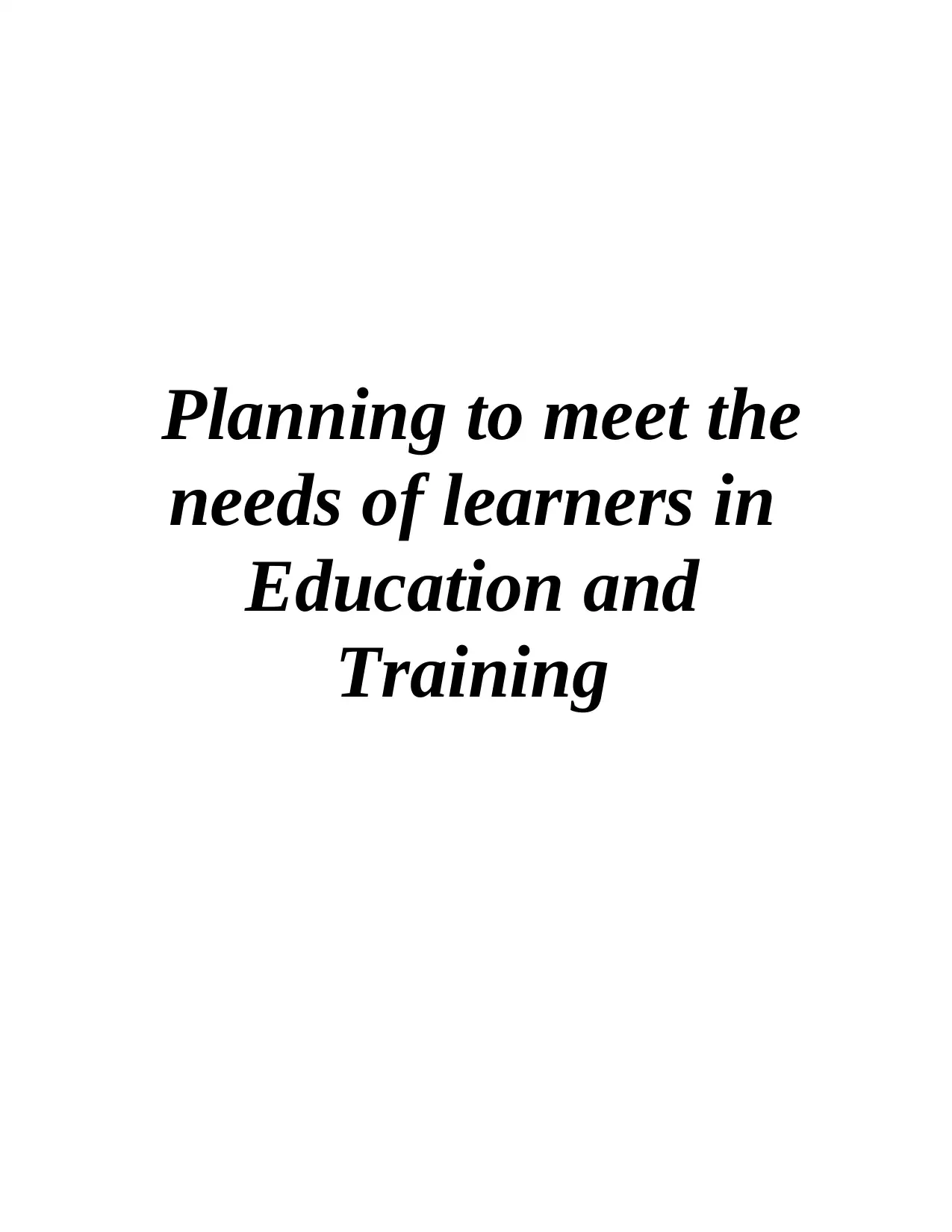
Planning to meet the
needs of learners in
Education and
Training
needs of learners in
Education and
Training
Paraphrase This Document
Need a fresh take? Get an instant paraphrase of this document with our AI Paraphraser
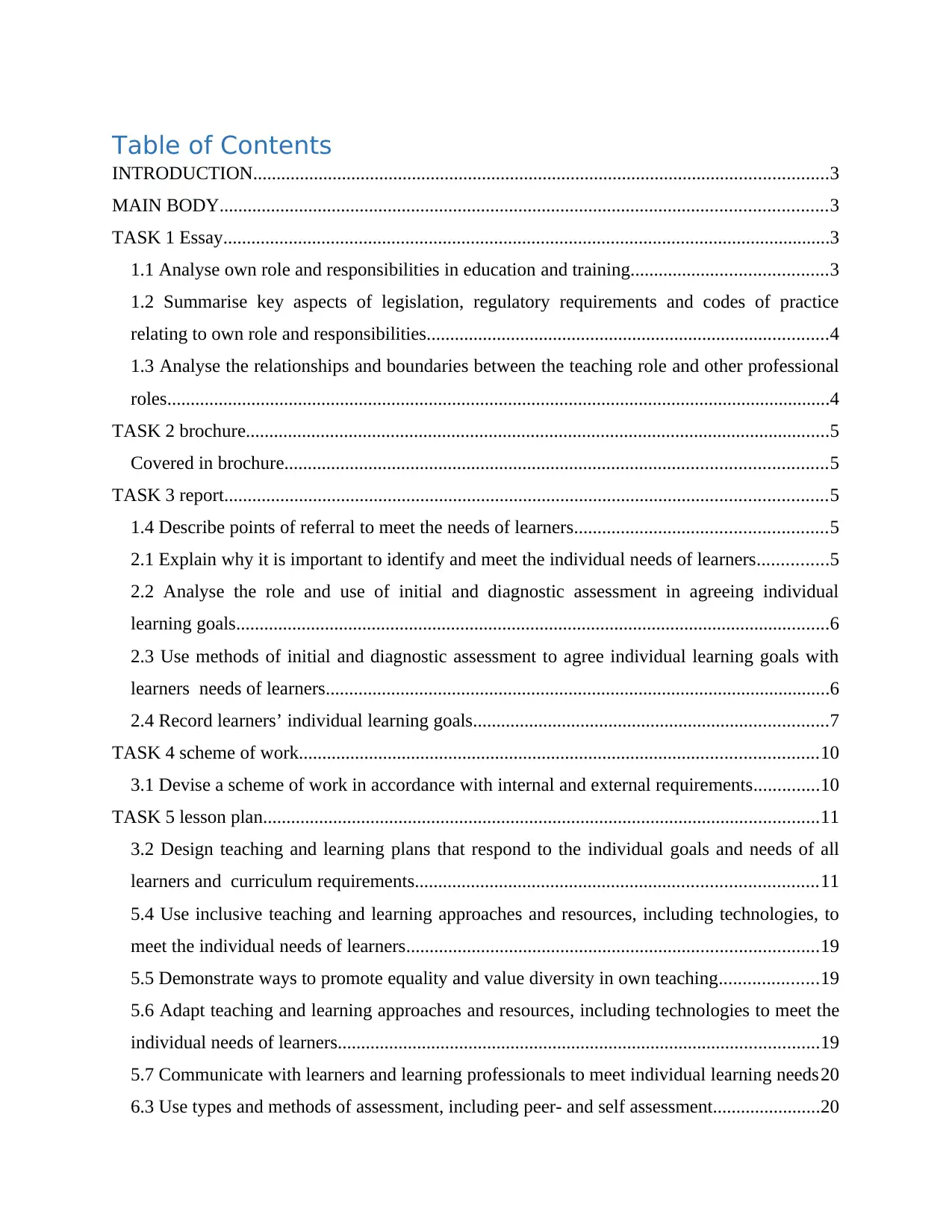
Table of Contents
INTRODUCTION...........................................................................................................................3
MAIN BODY..................................................................................................................................3
TASK 1 Essay..................................................................................................................................3
1.1 Analyse own role and responsibilities in education and training..........................................3
1.2 Summarise key aspects of legislation, regulatory requirements and codes of practice
relating to own role and responsibilities......................................................................................4
1.3 Analyse the relationships and boundaries between the teaching role and other professional
roles..............................................................................................................................................4
TASK 2 brochure.............................................................................................................................5
Covered in brochure....................................................................................................................5
TASK 3 report.................................................................................................................................5
1.4 Describe points of referral to meet the needs of learners......................................................5
2.1 Explain why it is important to identify and meet the individual needs of learners...............5
2.2 Analyse the role and use of initial and diagnostic assessment in agreeing individual
learning goals...............................................................................................................................6
2.3 Use methods of initial and diagnostic assessment to agree individual learning goals with
learners needs of learners............................................................................................................6
2.4 Record learners’ individual learning goals............................................................................7
TASK 4 scheme of work...............................................................................................................10
3.1 Devise a scheme of work in accordance with internal and external requirements..............10
TASK 5 lesson plan.......................................................................................................................11
3.2 Design teaching and learning plans that respond to the individual goals and needs of all
learners and curriculum requirements......................................................................................11
5.4 Use inclusive teaching and learning approaches and resources, including technologies, to
meet the individual needs of learners........................................................................................19
5.5 Demonstrate ways to promote equality and value diversity in own teaching.....................19
5.6 Adapt teaching and learning approaches and resources, including technologies to meet the
individual needs of learners.......................................................................................................19
5.7 Communicate with learners and learning professionals to meet individual learning needs20
6.3 Use types and methods of assessment, including peer- and self assessment.......................20
INTRODUCTION...........................................................................................................................3
MAIN BODY..................................................................................................................................3
TASK 1 Essay..................................................................................................................................3
1.1 Analyse own role and responsibilities in education and training..........................................3
1.2 Summarise key aspects of legislation, regulatory requirements and codes of practice
relating to own role and responsibilities......................................................................................4
1.3 Analyse the relationships and boundaries between the teaching role and other professional
roles..............................................................................................................................................4
TASK 2 brochure.............................................................................................................................5
Covered in brochure....................................................................................................................5
TASK 3 report.................................................................................................................................5
1.4 Describe points of referral to meet the needs of learners......................................................5
2.1 Explain why it is important to identify and meet the individual needs of learners...............5
2.2 Analyse the role and use of initial and diagnostic assessment in agreeing individual
learning goals...............................................................................................................................6
2.3 Use methods of initial and diagnostic assessment to agree individual learning goals with
learners needs of learners............................................................................................................6
2.4 Record learners’ individual learning goals............................................................................7
TASK 4 scheme of work...............................................................................................................10
3.1 Devise a scheme of work in accordance with internal and external requirements..............10
TASK 5 lesson plan.......................................................................................................................11
3.2 Design teaching and learning plans that respond to the individual goals and needs of all
learners and curriculum requirements......................................................................................11
5.4 Use inclusive teaching and learning approaches and resources, including technologies, to
meet the individual needs of learners........................................................................................19
5.5 Demonstrate ways to promote equality and value diversity in own teaching.....................19
5.6 Adapt teaching and learning approaches and resources, including technologies to meet the
individual needs of learners.......................................................................................................19
5.7 Communicate with learners and learning professionals to meet individual learning needs20
6.3 Use types and methods of assessment, including peer- and self assessment.......................20
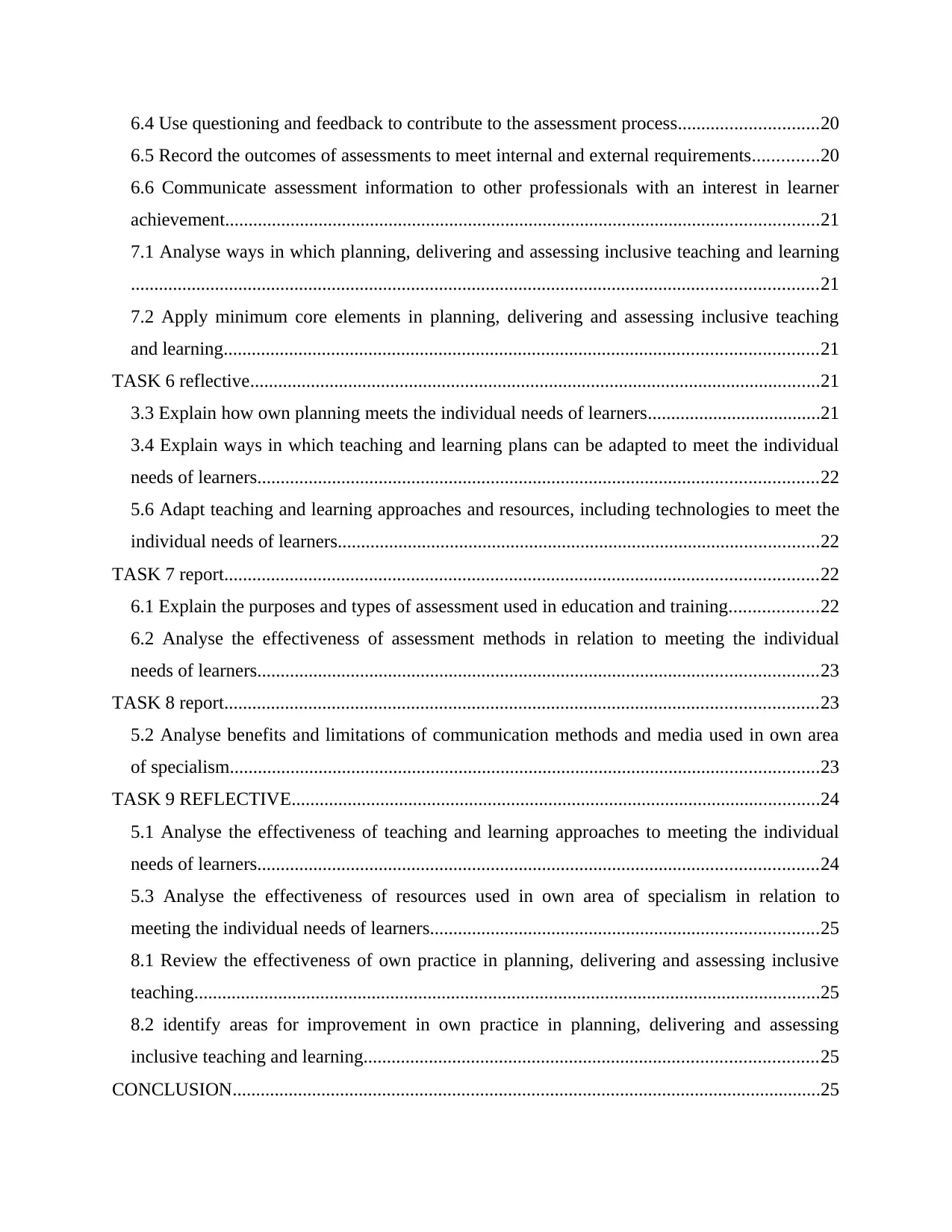
6.4 Use questioning and feedback to contribute to the assessment process..............................20
6.5 Record the outcomes of assessments to meet internal and external requirements..............20
6.6 Communicate assessment information to other professionals with an interest in learner
achievement...............................................................................................................................21
7.1 Analyse ways in which planning, delivering and assessing inclusive teaching and learning
...................................................................................................................................................21
7.2 Apply minimum core elements in planning, delivering and assessing inclusive teaching
and learning...............................................................................................................................21
TASK 6 reflective..........................................................................................................................21
3.3 Explain how own planning meets the individual needs of learners.....................................21
3.4 Explain ways in which teaching and learning plans can be adapted to meet the individual
needs of learners........................................................................................................................22
5.6 Adapt teaching and learning approaches and resources, including technologies to meet the
individual needs of learners.......................................................................................................22
TASK 7 report...............................................................................................................................22
6.1 Explain the purposes and types of assessment used in education and training...................22
6.2 Analyse the effectiveness of assessment methods in relation to meeting the individual
needs of learners........................................................................................................................23
TASK 8 report...............................................................................................................................23
5.2 Analyse benefits and limitations of communication methods and media used in own area
of specialism..............................................................................................................................23
TASK 9 REFLECTIVE.................................................................................................................24
5.1 Analyse the effectiveness of teaching and learning approaches to meeting the individual
needs of learners........................................................................................................................24
5.3 Analyse the effectiveness of resources used in own area of specialism in relation to
meeting the individual needs of learners...................................................................................25
8.1 Review the effectiveness of own practice in planning, delivering and assessing inclusive
teaching......................................................................................................................................25
8.2 identify areas for improvement in own practice in planning, delivering and assessing
inclusive teaching and learning.................................................................................................25
CONCLUSION..............................................................................................................................25
6.5 Record the outcomes of assessments to meet internal and external requirements..............20
6.6 Communicate assessment information to other professionals with an interest in learner
achievement...............................................................................................................................21
7.1 Analyse ways in which planning, delivering and assessing inclusive teaching and learning
...................................................................................................................................................21
7.2 Apply minimum core elements in planning, delivering and assessing inclusive teaching
and learning...............................................................................................................................21
TASK 6 reflective..........................................................................................................................21
3.3 Explain how own planning meets the individual needs of learners.....................................21
3.4 Explain ways in which teaching and learning plans can be adapted to meet the individual
needs of learners........................................................................................................................22
5.6 Adapt teaching and learning approaches and resources, including technologies to meet the
individual needs of learners.......................................................................................................22
TASK 7 report...............................................................................................................................22
6.1 Explain the purposes and types of assessment used in education and training...................22
6.2 Analyse the effectiveness of assessment methods in relation to meeting the individual
needs of learners........................................................................................................................23
TASK 8 report...............................................................................................................................23
5.2 Analyse benefits and limitations of communication methods and media used in own area
of specialism..............................................................................................................................23
TASK 9 REFLECTIVE.................................................................................................................24
5.1 Analyse the effectiveness of teaching and learning approaches to meeting the individual
needs of learners........................................................................................................................24
5.3 Analyse the effectiveness of resources used in own area of specialism in relation to
meeting the individual needs of learners...................................................................................25
8.1 Review the effectiveness of own practice in planning, delivering and assessing inclusive
teaching......................................................................................................................................25
8.2 identify areas for improvement in own practice in planning, delivering and assessing
inclusive teaching and learning.................................................................................................25
CONCLUSION..............................................................................................................................25
⊘ This is a preview!⊘
Do you want full access?
Subscribe today to unlock all pages.

Trusted by 1+ million students worldwide
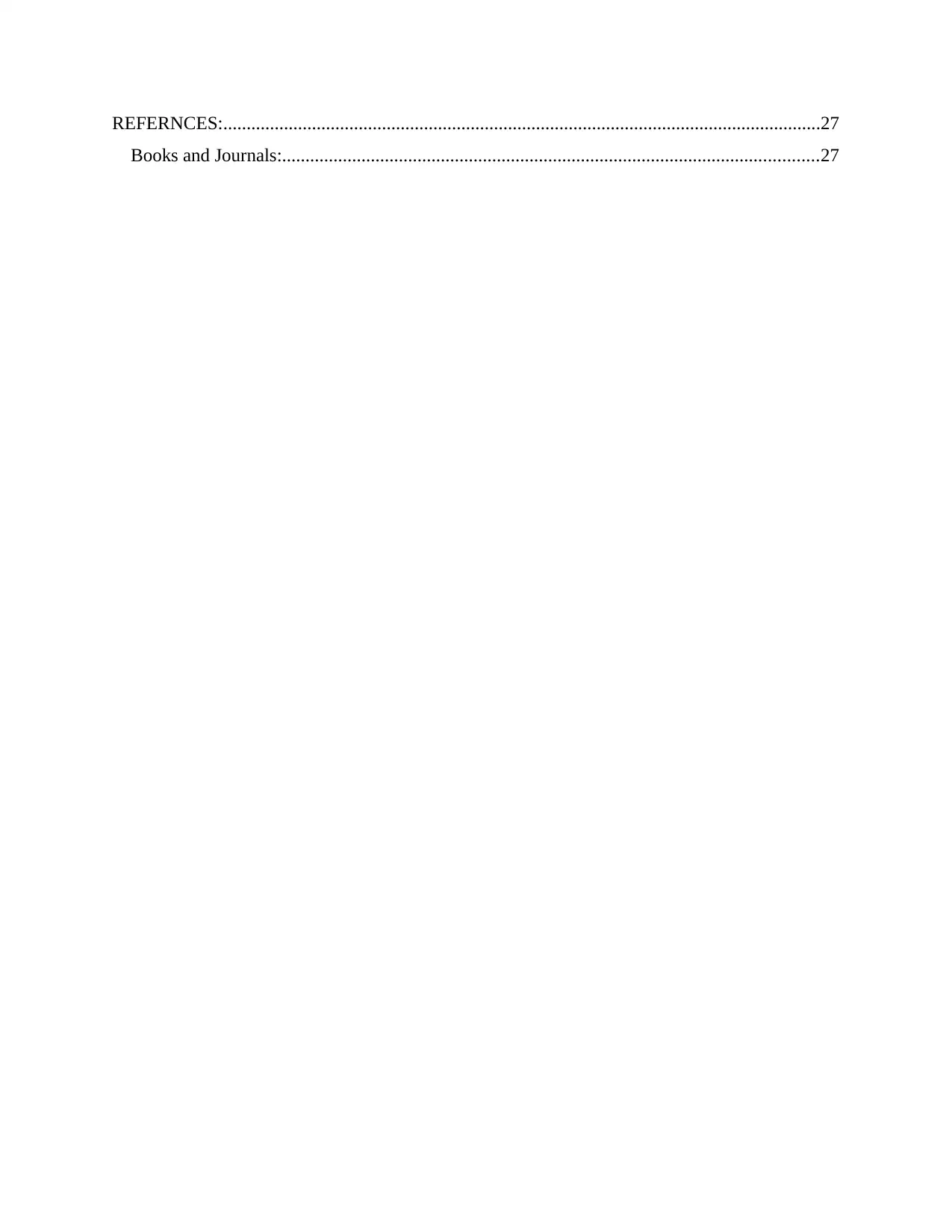
REFERNCES:................................................................................................................................27
Books and Journals:...................................................................................................................27
Books and Journals:...................................................................................................................27
Paraphrase This Document
Need a fresh take? Get an instant paraphrase of this document with our AI Paraphraser
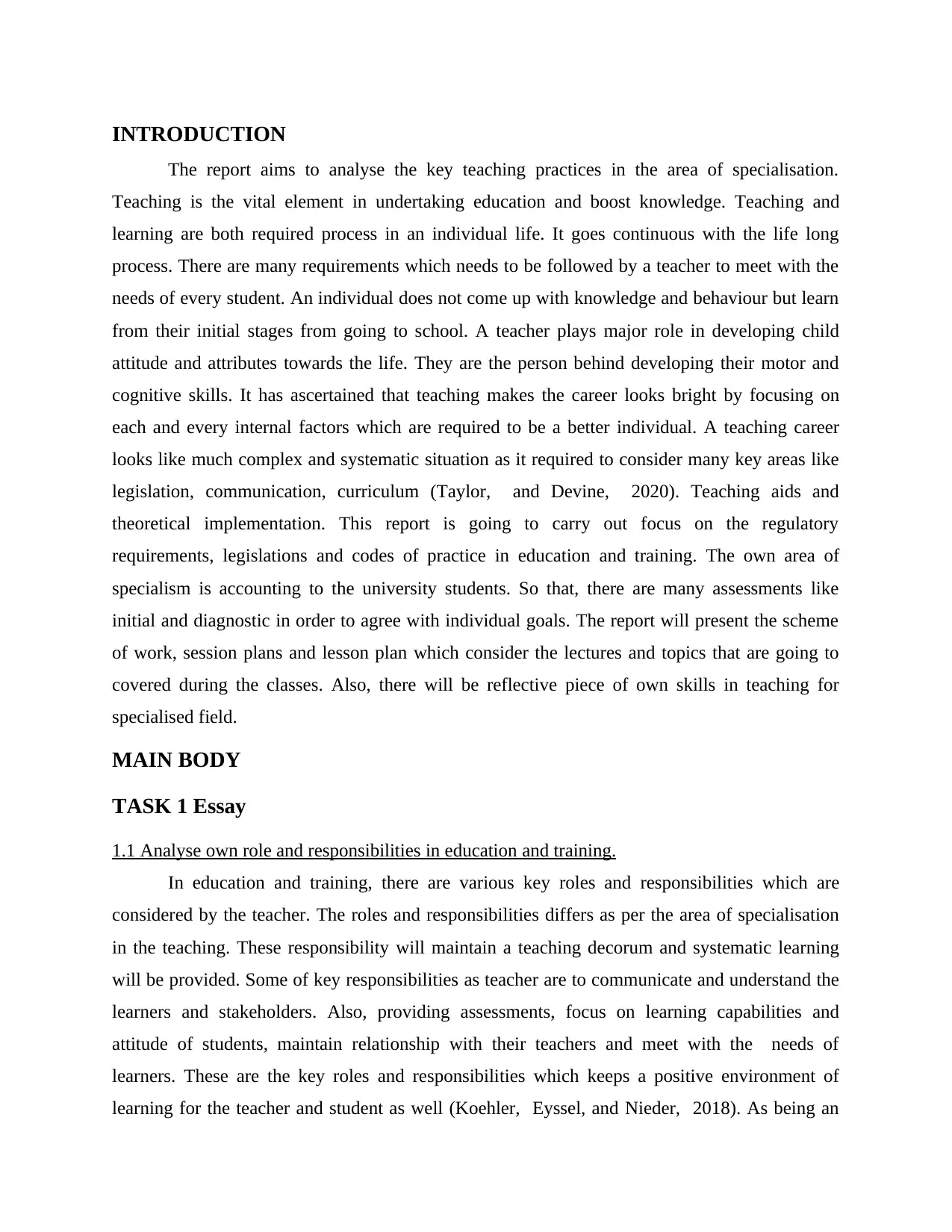
INTRODUCTION
The report aims to analyse the key teaching practices in the area of specialisation.
Teaching is the vital element in undertaking education and boost knowledge. Teaching and
learning are both required process in an individual life. It goes continuous with the life long
process. There are many requirements which needs to be followed by a teacher to meet with the
needs of every student. An individual does not come up with knowledge and behaviour but learn
from their initial stages from going to school. A teacher plays major role in developing child
attitude and attributes towards the life. They are the person behind developing their motor and
cognitive skills. It has ascertained that teaching makes the career looks bright by focusing on
each and every internal factors which are required to be a better individual. A teaching career
looks like much complex and systematic situation as it required to consider many key areas like
legislation, communication, curriculum (Taylor, and Devine, 2020). Teaching aids and
theoretical implementation. This report is going to carry out focus on the regulatory
requirements, legislations and codes of practice in education and training. The own area of
specialism is accounting to the university students. So that, there are many assessments like
initial and diagnostic in order to agree with individual goals. The report will present the scheme
of work, session plans and lesson plan which consider the lectures and topics that are going to
covered during the classes. Also, there will be reflective piece of own skills in teaching for
specialised field.
MAIN BODY
TASK 1 Essay
1.1 Analyse own role and responsibilities in education and training.
In education and training, there are various key roles and responsibilities which are
considered by the teacher. The roles and responsibilities differs as per the area of specialisation
in the teaching. These responsibility will maintain a teaching decorum and systematic learning
will be provided. Some of key responsibilities as teacher are to communicate and understand the
learners and stakeholders. Also, providing assessments, focus on learning capabilities and
attitude of students, maintain relationship with their teachers and meet with the needs of
learners. These are the key roles and responsibilities which keeps a positive environment of
learning for the teacher and student as well (Koehler, Eyssel, and Nieder, 2018). As being an
The report aims to analyse the key teaching practices in the area of specialisation.
Teaching is the vital element in undertaking education and boost knowledge. Teaching and
learning are both required process in an individual life. It goes continuous with the life long
process. There are many requirements which needs to be followed by a teacher to meet with the
needs of every student. An individual does not come up with knowledge and behaviour but learn
from their initial stages from going to school. A teacher plays major role in developing child
attitude and attributes towards the life. They are the person behind developing their motor and
cognitive skills. It has ascertained that teaching makes the career looks bright by focusing on
each and every internal factors which are required to be a better individual. A teaching career
looks like much complex and systematic situation as it required to consider many key areas like
legislation, communication, curriculum (Taylor, and Devine, 2020). Teaching aids and
theoretical implementation. This report is going to carry out focus on the regulatory
requirements, legislations and codes of practice in education and training. The own area of
specialism is accounting to the university students. So that, there are many assessments like
initial and diagnostic in order to agree with individual goals. The report will present the scheme
of work, session plans and lesson plan which consider the lectures and topics that are going to
covered during the classes. Also, there will be reflective piece of own skills in teaching for
specialised field.
MAIN BODY
TASK 1 Essay
1.1 Analyse own role and responsibilities in education and training.
In education and training, there are various key roles and responsibilities which are
considered by the teacher. The roles and responsibilities differs as per the area of specialisation
in the teaching. These responsibility will maintain a teaching decorum and systematic learning
will be provided. Some of key responsibilities as teacher are to communicate and understand the
learners and stakeholders. Also, providing assessments, focus on learning capabilities and
attitude of students, maintain relationship with their teachers and meet with the needs of
learners. These are the key roles and responsibilities which keeps a positive environment of
learning for the teacher and student as well (Koehler, Eyssel, and Nieder, 2018). As being an
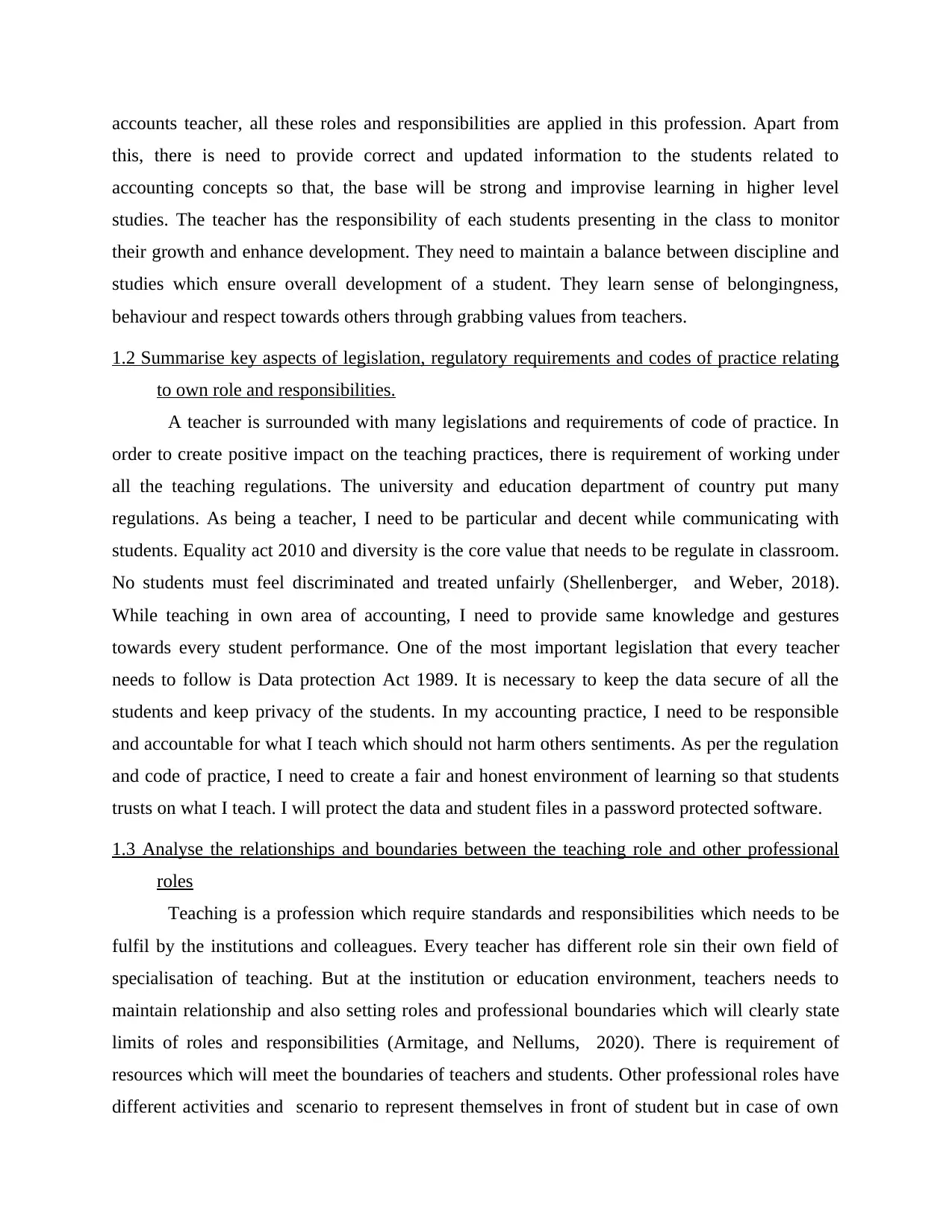
accounts teacher, all these roles and responsibilities are applied in this profession. Apart from
this, there is need to provide correct and updated information to the students related to
accounting concepts so that, the base will be strong and improvise learning in higher level
studies. The teacher has the responsibility of each students presenting in the class to monitor
their growth and enhance development. They need to maintain a balance between discipline and
studies which ensure overall development of a student. They learn sense of belongingness,
behaviour and respect towards others through grabbing values from teachers.
1.2 Summarise key aspects of legislation, regulatory requirements and codes of practice relating
to own role and responsibilities.
A teacher is surrounded with many legislations and requirements of code of practice. In
order to create positive impact on the teaching practices, there is requirement of working under
all the teaching regulations. The university and education department of country put many
regulations. As being a teacher, I need to be particular and decent while communicating with
students. Equality act 2010 and diversity is the core value that needs to be regulate in classroom.
No students must feel discriminated and treated unfairly (Shellenberger, and Weber, 2018).
While teaching in own area of accounting, I need to provide same knowledge and gestures
towards every student performance. One of the most important legislation that every teacher
needs to follow is Data protection Act 1989. It is necessary to keep the data secure of all the
students and keep privacy of the students. In my accounting practice, I need to be responsible
and accountable for what I teach which should not harm others sentiments. As per the regulation
and code of practice, I need to create a fair and honest environment of learning so that students
trusts on what I teach. I will protect the data and student files in a password protected software.
1.3 Analyse the relationships and boundaries between the teaching role and other professional
roles
Teaching is a profession which require standards and responsibilities which needs to be
fulfil by the institutions and colleagues. Every teacher has different role sin their own field of
specialisation of teaching. But at the institution or education environment, teachers needs to
maintain relationship and also setting roles and professional boundaries which will clearly state
limits of roles and responsibilities (Armitage, and Nellums, 2020). There is requirement of
resources which will meet the boundaries of teachers and students. Other professional roles have
different activities and scenario to represent themselves in front of student but in case of own
this, there is need to provide correct and updated information to the students related to
accounting concepts so that, the base will be strong and improvise learning in higher level
studies. The teacher has the responsibility of each students presenting in the class to monitor
their growth and enhance development. They need to maintain a balance between discipline and
studies which ensure overall development of a student. They learn sense of belongingness,
behaviour and respect towards others through grabbing values from teachers.
1.2 Summarise key aspects of legislation, regulatory requirements and codes of practice relating
to own role and responsibilities.
A teacher is surrounded with many legislations and requirements of code of practice. In
order to create positive impact on the teaching practices, there is requirement of working under
all the teaching regulations. The university and education department of country put many
regulations. As being a teacher, I need to be particular and decent while communicating with
students. Equality act 2010 and diversity is the core value that needs to be regulate in classroom.
No students must feel discriminated and treated unfairly (Shellenberger, and Weber, 2018).
While teaching in own area of accounting, I need to provide same knowledge and gestures
towards every student performance. One of the most important legislation that every teacher
needs to follow is Data protection Act 1989. It is necessary to keep the data secure of all the
students and keep privacy of the students. In my accounting practice, I need to be responsible
and accountable for what I teach which should not harm others sentiments. As per the regulation
and code of practice, I need to create a fair and honest environment of learning so that students
trusts on what I teach. I will protect the data and student files in a password protected software.
1.3 Analyse the relationships and boundaries between the teaching role and other professional
roles
Teaching is a profession which require standards and responsibilities which needs to be
fulfil by the institutions and colleagues. Every teacher has different role sin their own field of
specialisation of teaching. But at the institution or education environment, teachers needs to
maintain relationship and also setting roles and professional boundaries which will clearly state
limits of roles and responsibilities (Armitage, and Nellums, 2020). There is requirement of
resources which will meet the boundaries of teachers and students. Other professional roles have
different activities and scenario to represent themselves in front of student but in case of own
⊘ This is a preview!⊘
Do you want full access?
Subscribe today to unlock all pages.

Trusted by 1+ million students worldwide
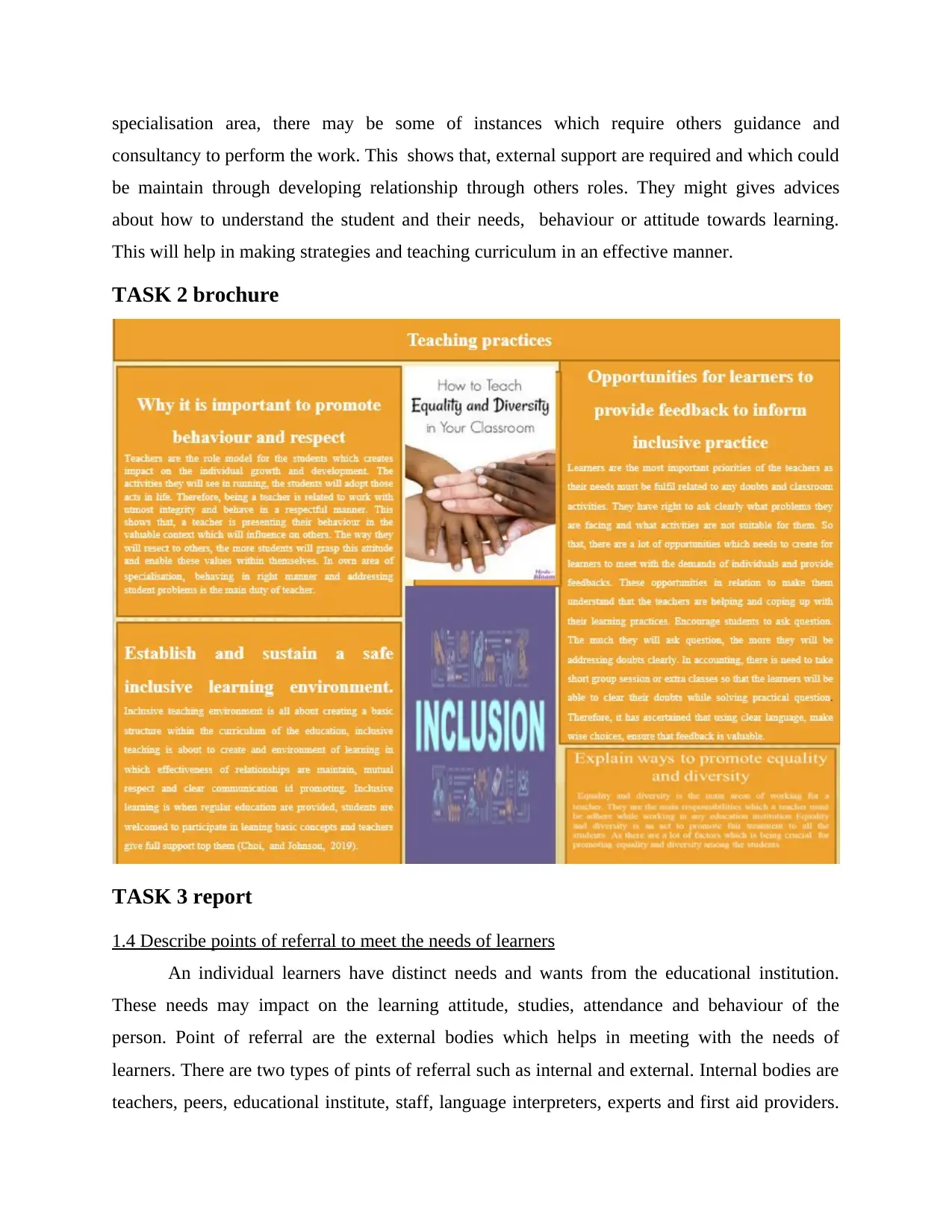
specialisation area, there may be some of instances which require others guidance and
consultancy to perform the work. This shows that, external support are required and which could
be maintain through developing relationship through others roles. They might gives advices
about how to understand the student and their needs, behaviour or attitude towards learning.
This will help in making strategies and teaching curriculum in an effective manner.
TASK 2 brochure
TASK 3 report
1.4 Describe points of referral to meet the needs of learners
An individual learners have distinct needs and wants from the educational institution.
These needs may impact on the learning attitude, studies, attendance and behaviour of the
person. Point of referral are the external bodies which helps in meeting with the needs of
learners. There are two types of pints of referral such as internal and external. Internal bodies are
teachers, peers, educational institute, staff, language interpreters, experts and first aid providers.
consultancy to perform the work. This shows that, external support are required and which could
be maintain through developing relationship through others roles. They might gives advices
about how to understand the student and their needs, behaviour or attitude towards learning.
This will help in making strategies and teaching curriculum in an effective manner.
TASK 2 brochure
TASK 3 report
1.4 Describe points of referral to meet the needs of learners
An individual learners have distinct needs and wants from the educational institution.
These needs may impact on the learning attitude, studies, attendance and behaviour of the
person. Point of referral are the external bodies which helps in meeting with the needs of
learners. There are two types of pints of referral such as internal and external. Internal bodies are
teachers, peers, educational institute, staff, language interpreters, experts and first aid providers.
Paraphrase This Document
Need a fresh take? Get an instant paraphrase of this document with our AI Paraphraser
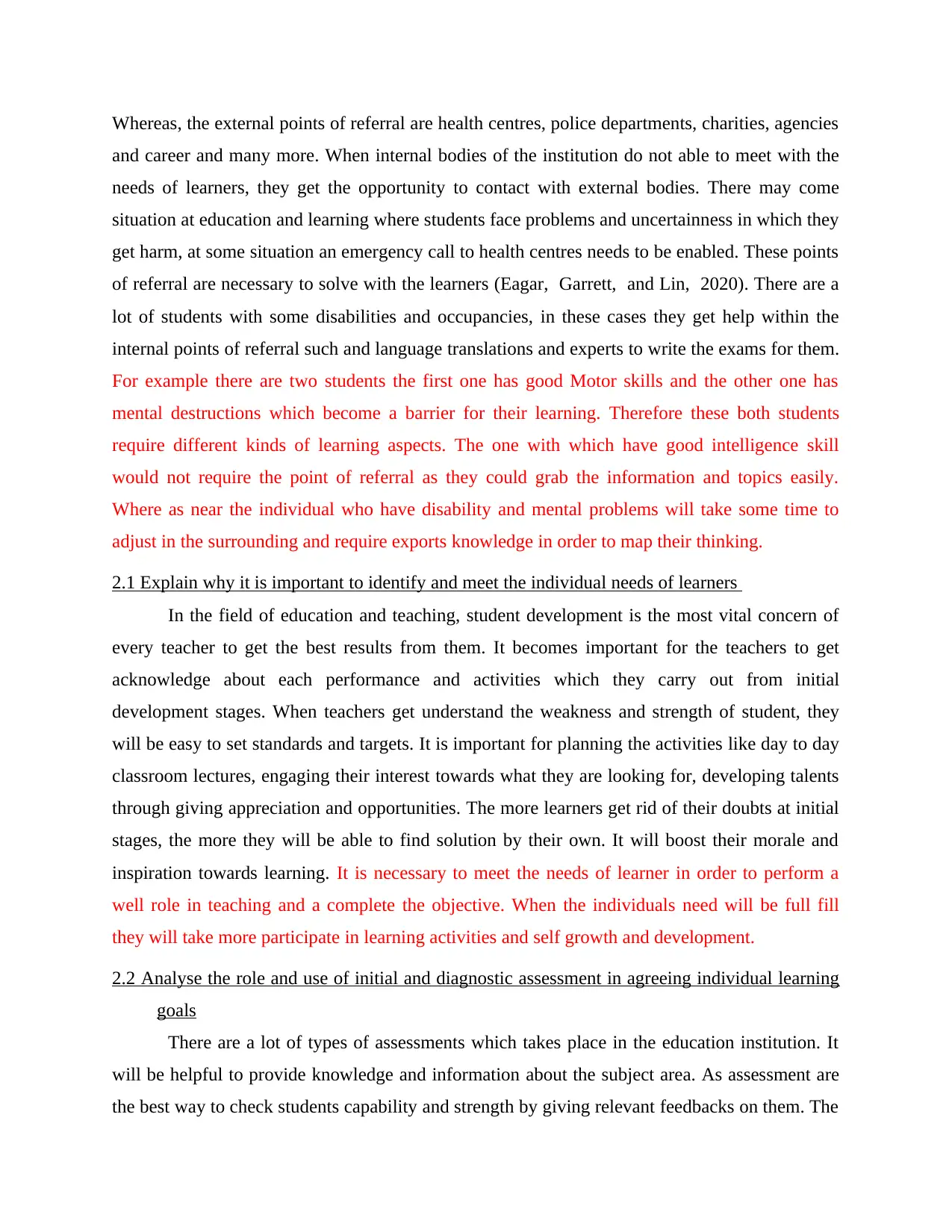
Whereas, the external points of referral are health centres, police departments, charities, agencies
and career and many more. When internal bodies of the institution do not able to meet with the
needs of learners, they get the opportunity to contact with external bodies. There may come
situation at education and learning where students face problems and uncertainness in which they
get harm, at some situation an emergency call to health centres needs to be enabled. These points
of referral are necessary to solve with the learners (Eagar, Garrett, and Lin, 2020). There are a
lot of students with some disabilities and occupancies, in these cases they get help within the
internal points of referral such and language translations and experts to write the exams for them.
For example there are two students the first one has good Motor skills and the other one has
mental destructions which become a barrier for their learning. Therefore these both students
require different kinds of learning aspects. The one with which have good intelligence skill
would not require the point of referral as they could grab the information and topics easily.
Where as near the individual who have disability and mental problems will take some time to
adjust in the surrounding and require exports knowledge in order to map their thinking.
2.1 Explain why it is important to identify and meet the individual needs of learners
In the field of education and teaching, student development is the most vital concern of
every teacher to get the best results from them. It becomes important for the teachers to get
acknowledge about each performance and activities which they carry out from initial
development stages. When teachers get understand the weakness and strength of student, they
will be easy to set standards and targets. It is important for planning the activities like day to day
classroom lectures, engaging their interest towards what they are looking for, developing talents
through giving appreciation and opportunities. The more learners get rid of their doubts at initial
stages, the more they will be able to find solution by their own. It will boost their morale and
inspiration towards learning. It is necessary to meet the needs of learner in order to perform a
well role in teaching and a complete the objective. When the individuals need will be full fill
they will take more participate in learning activities and self growth and development.
2.2 Analyse the role and use of initial and diagnostic assessment in agreeing individual learning
goals
There are a lot of types of assessments which takes place in the education institution. It
will be helpful to provide knowledge and information about the subject area. As assessment are
the best way to check students capability and strength by giving relevant feedbacks on them. The
and career and many more. When internal bodies of the institution do not able to meet with the
needs of learners, they get the opportunity to contact with external bodies. There may come
situation at education and learning where students face problems and uncertainness in which they
get harm, at some situation an emergency call to health centres needs to be enabled. These points
of referral are necessary to solve with the learners (Eagar, Garrett, and Lin, 2020). There are a
lot of students with some disabilities and occupancies, in these cases they get help within the
internal points of referral such and language translations and experts to write the exams for them.
For example there are two students the first one has good Motor skills and the other one has
mental destructions which become a barrier for their learning. Therefore these both students
require different kinds of learning aspects. The one with which have good intelligence skill
would not require the point of referral as they could grab the information and topics easily.
Where as near the individual who have disability and mental problems will take some time to
adjust in the surrounding and require exports knowledge in order to map their thinking.
2.1 Explain why it is important to identify and meet the individual needs of learners
In the field of education and teaching, student development is the most vital concern of
every teacher to get the best results from them. It becomes important for the teachers to get
acknowledge about each performance and activities which they carry out from initial
development stages. When teachers get understand the weakness and strength of student, they
will be easy to set standards and targets. It is important for planning the activities like day to day
classroom lectures, engaging their interest towards what they are looking for, developing talents
through giving appreciation and opportunities. The more learners get rid of their doubts at initial
stages, the more they will be able to find solution by their own. It will boost their morale and
inspiration towards learning. It is necessary to meet the needs of learner in order to perform a
well role in teaching and a complete the objective. When the individuals need will be full fill
they will take more participate in learning activities and self growth and development.
2.2 Analyse the role and use of initial and diagnostic assessment in agreeing individual learning
goals
There are a lot of types of assessments which takes place in the education institution. It
will be helpful to provide knowledge and information about the subject area. As assessment are
the best way to check students capability and strength by giving relevant feedbacks on them. The
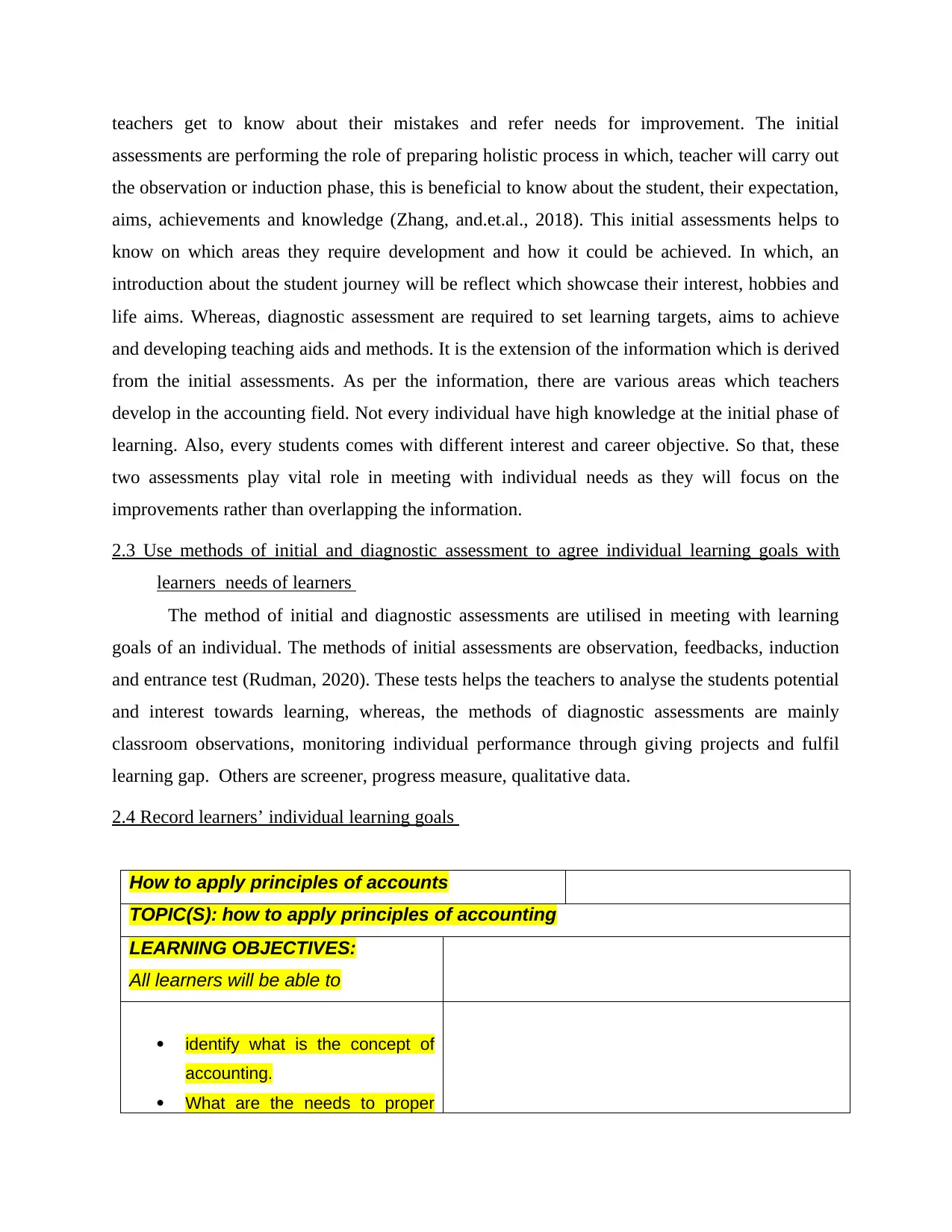
teachers get to know about their mistakes and refer needs for improvement. The initial
assessments are performing the role of preparing holistic process in which, teacher will carry out
the observation or induction phase, this is beneficial to know about the student, their expectation,
aims, achievements and knowledge (Zhang, and.et.al., 2018). This initial assessments helps to
know on which areas they require development and how it could be achieved. In which, an
introduction about the student journey will be reflect which showcase their interest, hobbies and
life aims. Whereas, diagnostic assessment are required to set learning targets, aims to achieve
and developing teaching aids and methods. It is the extension of the information which is derived
from the initial assessments. As per the information, there are various areas which teachers
develop in the accounting field. Not every individual have high knowledge at the initial phase of
learning. Also, every students comes with different interest and career objective. So that, these
two assessments play vital role in meeting with individual needs as they will focus on the
improvements rather than overlapping the information.
2.3 Use methods of initial and diagnostic assessment to agree individual learning goals with
learners needs of learners
The method of initial and diagnostic assessments are utilised in meeting with learning
goals of an individual. The methods of initial assessments are observation, feedbacks, induction
and entrance test (Rudman, 2020). These tests helps the teachers to analyse the students potential
and interest towards learning, whereas, the methods of diagnostic assessments are mainly
classroom observations, monitoring individual performance through giving projects and fulfil
learning gap. Others are screener, progress measure, qualitative data.
2.4 Record learners’ individual learning goals
How to apply principles of accounts
TOPIC(S): how to apply principles of accounting
LEARNING OBJECTIVES:
All learners will be able to
identify what is the concept of
accounting.
What are the needs to proper
assessments are performing the role of preparing holistic process in which, teacher will carry out
the observation or induction phase, this is beneficial to know about the student, their expectation,
aims, achievements and knowledge (Zhang, and.et.al., 2018). This initial assessments helps to
know on which areas they require development and how it could be achieved. In which, an
introduction about the student journey will be reflect which showcase their interest, hobbies and
life aims. Whereas, diagnostic assessment are required to set learning targets, aims to achieve
and developing teaching aids and methods. It is the extension of the information which is derived
from the initial assessments. As per the information, there are various areas which teachers
develop in the accounting field. Not every individual have high knowledge at the initial phase of
learning. Also, every students comes with different interest and career objective. So that, these
two assessments play vital role in meeting with individual needs as they will focus on the
improvements rather than overlapping the information.
2.3 Use methods of initial and diagnostic assessment to agree individual learning goals with
learners needs of learners
The method of initial and diagnostic assessments are utilised in meeting with learning
goals of an individual. The methods of initial assessments are observation, feedbacks, induction
and entrance test (Rudman, 2020). These tests helps the teachers to analyse the students potential
and interest towards learning, whereas, the methods of diagnostic assessments are mainly
classroom observations, monitoring individual performance through giving projects and fulfil
learning gap. Others are screener, progress measure, qualitative data.
2.4 Record learners’ individual learning goals
How to apply principles of accounts
TOPIC(S): how to apply principles of accounting
LEARNING OBJECTIVES:
All learners will be able to
identify what is the concept of
accounting.
What are the needs to proper
⊘ This is a preview!⊘
Do you want full access?
Subscribe today to unlock all pages.

Trusted by 1+ million students worldwide
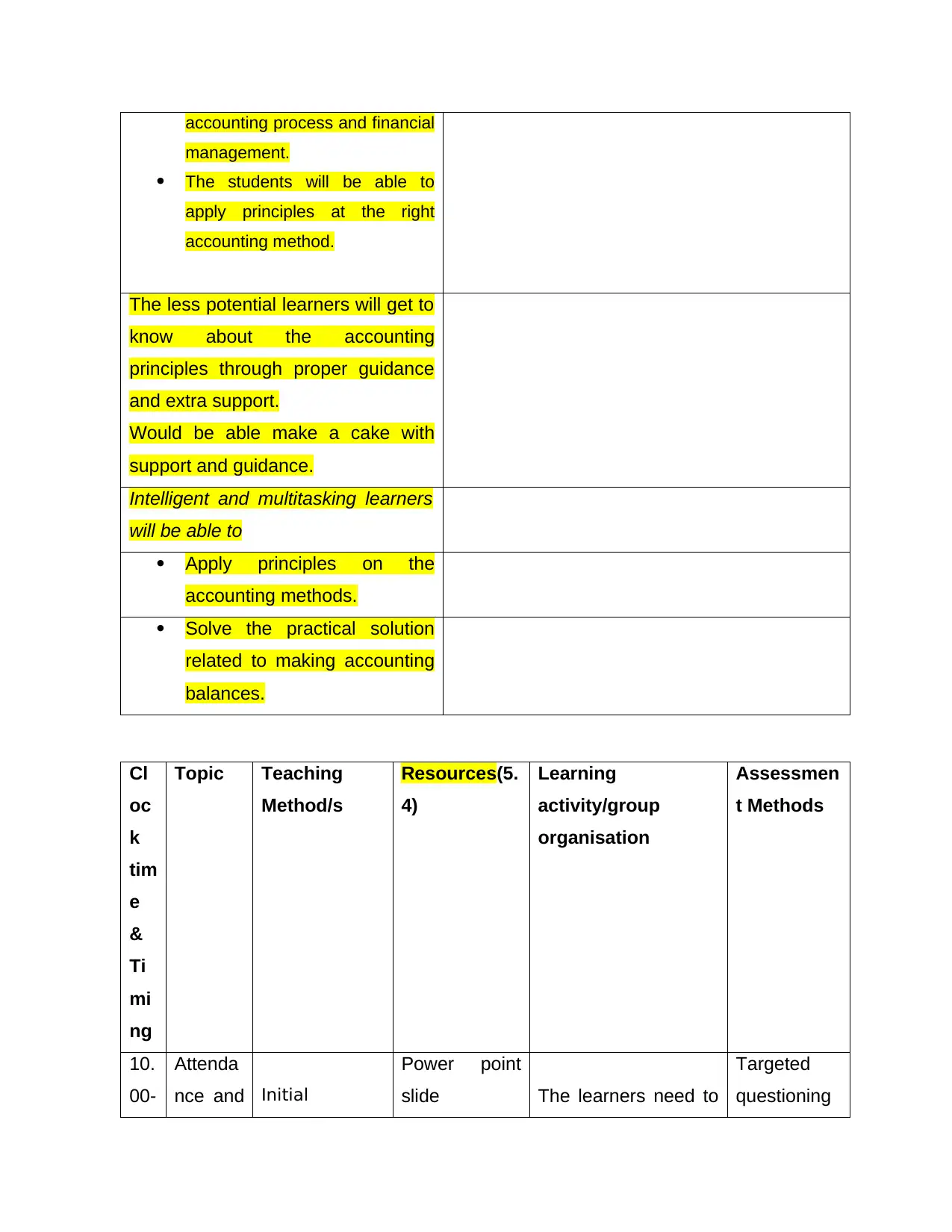
accounting process and financial
management.
The students will be able to
apply principles at the right
accounting method.
The less potential learners will get to
know about the accounting
principles through proper guidance
and extra support.
Would be able make a cake with
support and guidance.
Intelligent and multitasking learners
will be able to
Apply principles on the
accounting methods.
Solve the practical solution
related to making accounting
balances.
Cl
oc
k
tim
e
&
Ti
mi
ng
Topic Teaching
Method/s
Resources(5.
4)
Learning
activity/group
organisation
Assessmen
t Methods
10.
00-
Attenda
nce and Initial
Power point
slide The learners need to
Targeted
questioning
management.
The students will be able to
apply principles at the right
accounting method.
The less potential learners will get to
know about the accounting
principles through proper guidance
and extra support.
Would be able make a cake with
support and guidance.
Intelligent and multitasking learners
will be able to
Apply principles on the
accounting methods.
Solve the practical solution
related to making accounting
balances.
Cl
oc
k
tim
e
&
Ti
mi
ng
Topic Teaching
Method/s
Resources(5.
4)
Learning
activity/group
organisation
Assessmen
t Methods
10.
00-
Attenda
nce and Initial
Power point
slide The learners need to
Targeted
questioning
Paraphrase This Document
Need a fresh take? Get an instant paraphrase of this document with our AI Paraphraser
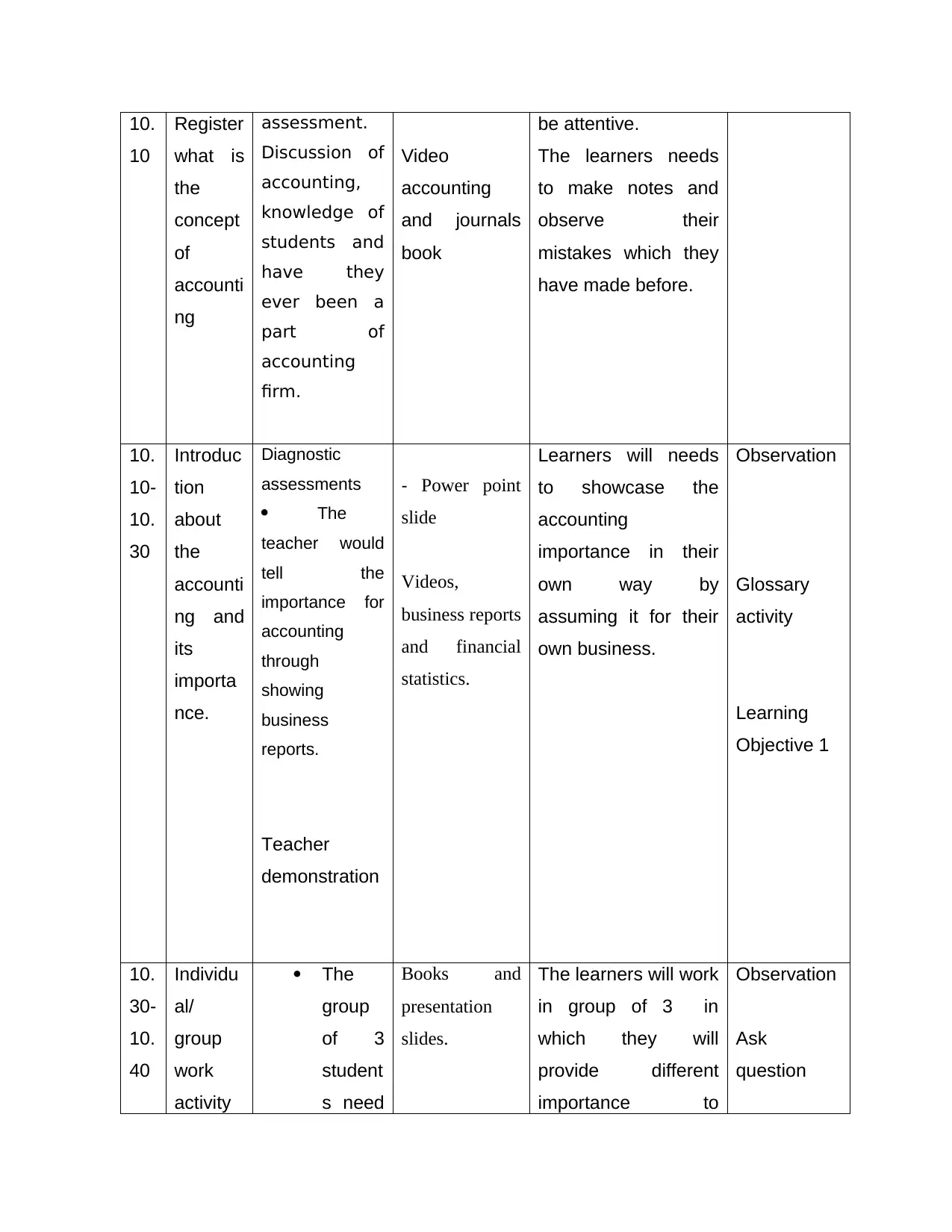
10.
10
Register
what is
the
concept
of
accounti
ng
assessment.
Discussion of
accounting,
knowledge of
students and
have they
ever been a
part of
accounting
firm.
Video
accounting
and journals
book
be attentive.
The learners needs
to make notes and
observe their
mistakes which they
have made before.
10.
10-
10.
30
Introduc
tion
about
the
accounti
ng and
its
importa
nce.
Diagnostic
assessments
The
teacher would
tell the
importance for
accounting
through
showing
business
reports.
Teacher
demonstration
- Power point
slide
Videos,
business reports
and financial
statistics.
Learners will needs
to showcase the
accounting
importance in their
own way by
assuming it for their
own business.
Observation
Glossary
activity
Learning
Objective 1
10.
30-
10.
40
Individu
al/
group
work
activity
The
group
of 3
student
s need
Books and
presentation
slides.
The learners will work
in group of 3 in
which they will
provide different
importance to
Observation
Ask
question
10
Register
what is
the
concept
of
accounti
ng
assessment.
Discussion of
accounting,
knowledge of
students and
have they
ever been a
part of
accounting
firm.
Video
accounting
and journals
book
be attentive.
The learners needs
to make notes and
observe their
mistakes which they
have made before.
10.
10-
10.
30
Introduc
tion
about
the
accounti
ng and
its
importa
nce.
Diagnostic
assessments
The
teacher would
tell the
importance for
accounting
through
showing
business
reports.
Teacher
demonstration
- Power point
slide
Videos,
business reports
and financial
statistics.
Learners will needs
to showcase the
accounting
importance in their
own way by
assuming it for their
own business.
Observation
Glossary
activity
Learning
Objective 1
10.
30-
10.
40
Individu
al/
group
work
activity
The
group
of 3
student
s need
Books and
presentation
slides.
The learners will work
in group of 3 in
which they will
provide different
importance to
Observation
Ask
question
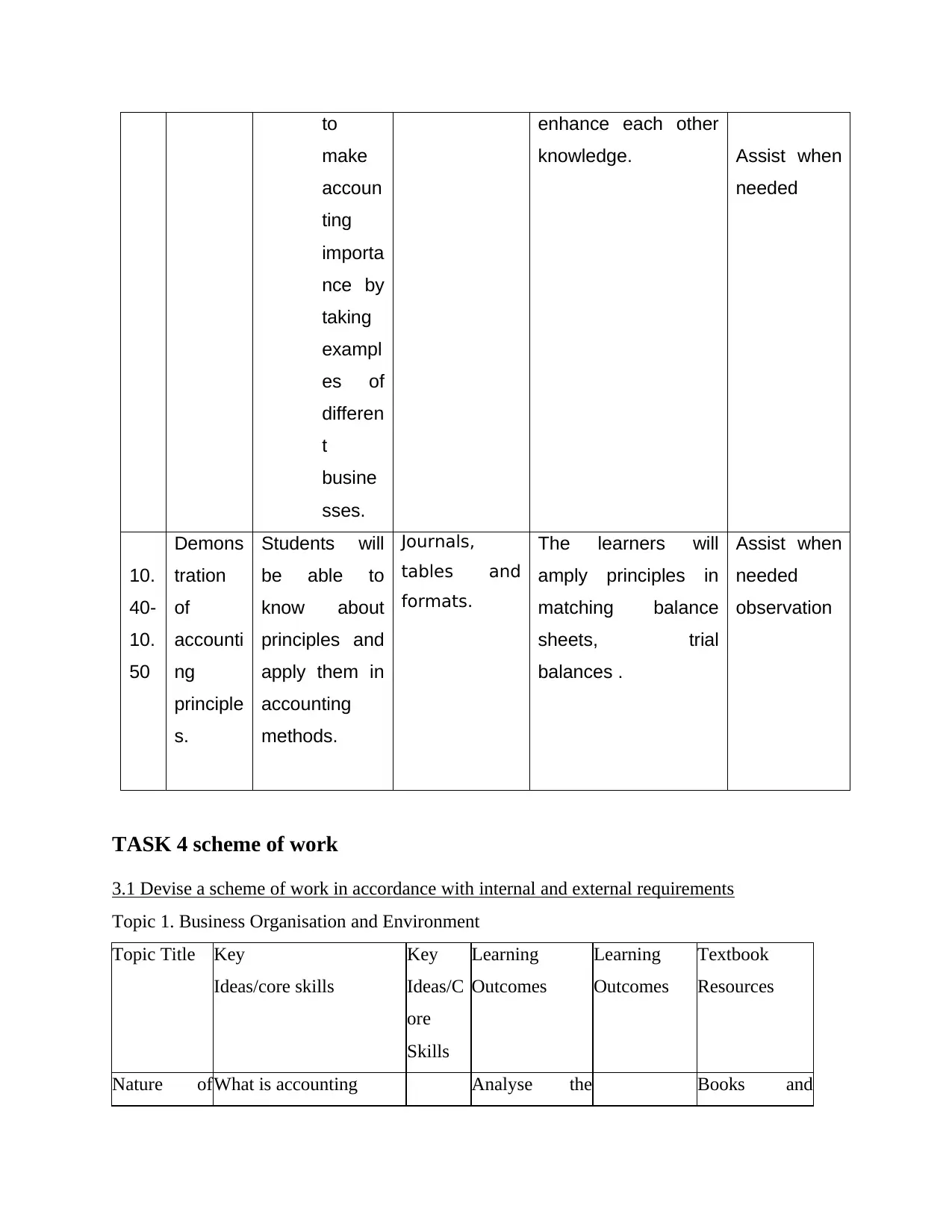
to
make
accoun
ting
importa
nce by
taking
exampl
es of
differen
t
busine
sses.
enhance each other
knowledge. Assist when
needed
10.
40-
10.
50
Demons
tration
of
accounti
ng
principle
s.
Students will
be able to
know about
principles and
apply them in
accounting
methods.
Journals,
tables and
formats.
The learners will
amply principles in
matching balance
sheets, trial
balances .
Assist when
needed
observation
TASK 4 scheme of work
3.1 Devise a scheme of work in accordance with internal and external requirements
Topic 1. Business Organisation and Environment
Topic Title Key
Ideas/core skills
Key
Ideas/C
ore
Skills
Learning
Outcomes
Learning
Outcomes
Textbook
Resources
Nature ofWhat is accounting Analyse the Books and
make
accoun
ting
importa
nce by
taking
exampl
es of
differen
t
busine
sses.
enhance each other
knowledge. Assist when
needed
10.
40-
10.
50
Demons
tration
of
accounti
ng
principle
s.
Students will
be able to
know about
principles and
apply them in
accounting
methods.
Journals,
tables and
formats.
The learners will
amply principles in
matching balance
sheets, trial
balances .
Assist when
needed
observation
TASK 4 scheme of work
3.1 Devise a scheme of work in accordance with internal and external requirements
Topic 1. Business Organisation and Environment
Topic Title Key
Ideas/core skills
Key
Ideas/C
ore
Skills
Learning
Outcomes
Learning
Outcomes
Textbook
Resources
Nature ofWhat is accounting Analyse the Books and
⊘ This is a preview!⊘
Do you want full access?
Subscribe today to unlock all pages.

Trusted by 1+ million students worldwide
1 out of 31
Related Documents
Your All-in-One AI-Powered Toolkit for Academic Success.
+13062052269
info@desklib.com
Available 24*7 on WhatsApp / Email
![[object Object]](/_next/static/media/star-bottom.7253800d.svg)
Unlock your academic potential
Copyright © 2020–2025 A2Z Services. All Rights Reserved. Developed and managed by ZUCOL.




